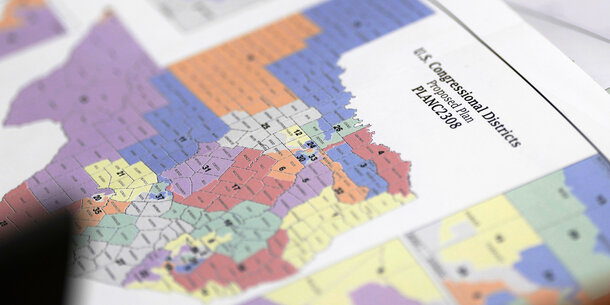As mandated by the Constitution, every 10 years congressional seats must be reapportioned and each state must redraw its congressional map. With the 2021–22 redistricting cycle now well underway, slightly more than half the states have completed the process. Already, this cycle appears to be one of the most abuse laden in U.S. history. There are a few notable bright spots, but in many states, racial discrimination and extreme gerrymandering are once again prolific.
Predictably, many of this round’s biased maps achieve their skew at the expense of communities of color. Over the past decade, communities of color accounted for nearly all of the country’s population growth. But in redrawing boundaries, Republican map drawers, especially in the South, haven’t just declined to create any new electoral opportunities for these fast-growing communities; in many instances they have dismantled existing districts where communities of color won power or were on the verge of doing so. This brazen attack is unprecedented in scale. In state after state, Republicans are claiming that they are drawing maps on a “race-blind” basis and then defending the resulting racially discriminatory maps on the basis of partisanship, cynically exploiting the loophole left when the Supreme Court declared that federal courts were off-limits to constitutional challenges to partisan gerrymandering. If courts are not willing to carefully probe the intersection of race and politics, the ruse may just succeed.
Democrats have tried to counteract Republican gerrymandering with aggressive line drawing of their own, but the playing field is not level. Republicans control the drawing of 187 congressional districts in this redistricting cycle; Democrats just 75. If, in the end, the cycle does not end up a wholesale disaster for Democrats, this will largely be attributable to three factors: the unwinding of gerrymanders in states like Michigan with reformed processes, court-drawn maps in states where the redistricting process has deadlocked, and litigation in states where state courts, unlike their federal counterparts, will hear partisan gerrymandering claims.
In states where legislatures draw maps, many of this cycle’s new maps are breathtaking in their aggressiveness. Republicans in North Carolina, for example, converted a congressional map that elected 8 Republicans and 5 Democrats (already a skewed map for an almost evenly divided battleground state) into one that could elect as many as 11 Republicans and just 3 Democrats. Under the redrawn map, even if Democrats get 52 percent of the vote, they will win no more than 29 percent of the seats. The map, moreover, achieves its partisan skew with a shocking targeting of Black political power, making the seat of one of the two Black members of the state’s congressional delegation much less likely to elect a minority-preferred candidate. As a result, a state that is one-fifth Black could have only a single Black member of the U.S. House come next January.
North Carolina is extreme but hardly an outlier. Of the maps passed as of the end of 2021, GOP-passed congressional maps in Texas, Ohio, and Georgia are also severe partisan gerrymanders under standards in the proposed Freedom to Vote: John R. Lewis Act, and others are not far behind. Democratic-drawn congressional maps in Illinois, Maryland, and Oregon also are sufficiently skewed that they would trigger court review under the bill.
The problem, moreover, isn’t just that the parties are drawing skewed maps. Republicans in particular are drawing them in a way that aggressively takes competition off the table. Early indications are that by the time the latest round of redistricting is done, by March or shortly thereafter, there will be significantly fewer competitive districts for Democrats than there were in 2018 or 2020. Should Democrats lose their majority in the U.S. House in the 2022 midterms, as many expect, their road back to a majority in 2024, 2026, or even 2028 will be harder, especially if the expanded Democratic coalition of recent years changes unexpectedly.
Lawsuits will help mitigate these abuses, especially in states where litigation in state courts is a possibility. But overall, winning map changes will be harder than it was 10 years ago because of a fraying legal framework. In addition to seeing racially discriminatory maps defended as legally permitted partisan gerrymanders, expect multiple attacks, big and small, on what remains of the Voting Rights Act of 1965 (VRA). Some have already begun in Texas.
However, the story of the 2021–22 redistricting cycle isn’t yet written in stone. As bad as many of the maps drawn thus far are, Congress could upend gerrymandering and racial discrimination by passing the Freedom to Vote: John R. Lewis Act. If Congress acts quickly enough, it may even be possible to make changes to maps in time for the 2022 midterms. The bill would transform a broken map-drawing process by giving voters powerful new tools to fight both racial and partisan discrimination, including a statutory ban on extreme gerrymandering that would eliminate the loophole states are using to defend racially discriminatory maps. But time is running out. The 2022 primaries soon will be well underway in much of the country, and in short order courts will likely conclude that it is simply too late to make changes to maps for this election cycle.
Key Observations
- Attacks on minority communities. This cycle is seeing unprecedented efforts to undermine the political power of Black, Latino, Asian, and Native communities through redistricting, especially in southern states that, for the first time in more than half a century, are no longer covered by Section 5 of the Voting Rights Act, which before 2013 required states with a history of racial discrimination to get new maps preapproved by the Justice Department or a federal court before putting them into effect.
- This cycle is seeing unprecedented efforts to undermine the political power of Black, Latino, Asian, and Native communities through redistricting, especially in southern states that, for the first time in more than half a century, are no longer covered by Section 5 of the Voting Rights Act, which before 2013 required states with a history of racial discrimination to get new maps preapproved by the Justice Department or a federal court before putting them into effect.
- The South also will see renewed legal fights over the failure of lawmakers to create a sufficient number of Black opportunity districts in Alabama and North Carolina and Latino opportunity districts in Texas. The recently enacted congressional map in Arkansas also is expected to be challenged on racial discrimination grounds.
- All told, voting rights advocates have raised significant concerns about the racial fairness of enacted or proposed congressional or legislative maps in seven southern states: Alabama, Arkansas, Georgia, Mississippi, North Carolina, South Carolina, and Texas.
- Deeply skewed maps. Republicans will enjoy an advantage this decade in the battle for control of Congress if new maps stand.
- In Texas, Georgia, and North Carolina — three of the four states that the Brennan Center has flagged as being at the greatest risk of discriminatory line drawing — new maps would have given Republicans 6 to 9 more congressional seats in 2020 than they would have won under neutral plans. Add to that the impact of an extreme gerrymander in Ohio and selective gerrymandering in smaller states like Utah, and Republicans would have won 8 to 15 more seats in 2020 under the new maps than under neutral plans.
- Gerrymandering in states Democrats control and the unwinding of existing pro-GOP gerrymanders in other states will offset this advantage somewhat but likely not completely. Individually and collectively, the nation’s maps will continue to have a skew favoring Republicans.
- A decrease in competition in Republican-controlled states. The number of competitive districts will decrease sharply as a result of redistricting. This reduction will be especially notable in Republican-controlled states, where Republicans’ defensive gerrymanders have made the seats they currently hold much safer. Under old maps, Donald Trump won 54 congressional districts in GOP-controlled states by 15 or more percentage points. Under new maps, that number grows to 70, an increase of almost 30 percent. By contrast, the number of districts in Democratic-controlled states that Joe Biden won by 15 or more points remains flat at 29 between the old and new maps. Competitiveness, likewise, remains largely unchanged in states with commission-drawn maps.
- Successful state-level redistricting reforms, but not everywhere. Redistricting reforms have been greatly successful in creating fairer maps in some states, most notably Michigan, one of the past decade’s most gerrymandered states. But elsewhere, the record of recent reforms is mixed. This is especially the case where reforms imposed new rules but left line-drawing responsibility in the hands of partisan lawmakers (as in Ohio) or where partisan lawmakers could simply override a map passed by an advisory commission to adopt a gerrymandered one (as happened in Utah). The lesson: Reforms can work, but the details of their design matter.
- The potential impact of the Freedom to Vote: John R. Lewis Act. If passed, the federal legislation would greatly mitigate this decade’s gerrymanders. Newly adopted congressional maps in seven Republican-controlled states and five Democratic-controlled states would be presumed to be illegal partisan gerrymanders under the legislation because of high rates of bias and would be blocked from being used unless and until a state established that no fairer map could be drawn. But timing of passage will be critical. If the bill does not pass early in 2022, it is likely that changes to maps will have to wait for the 2024 election cycle.






